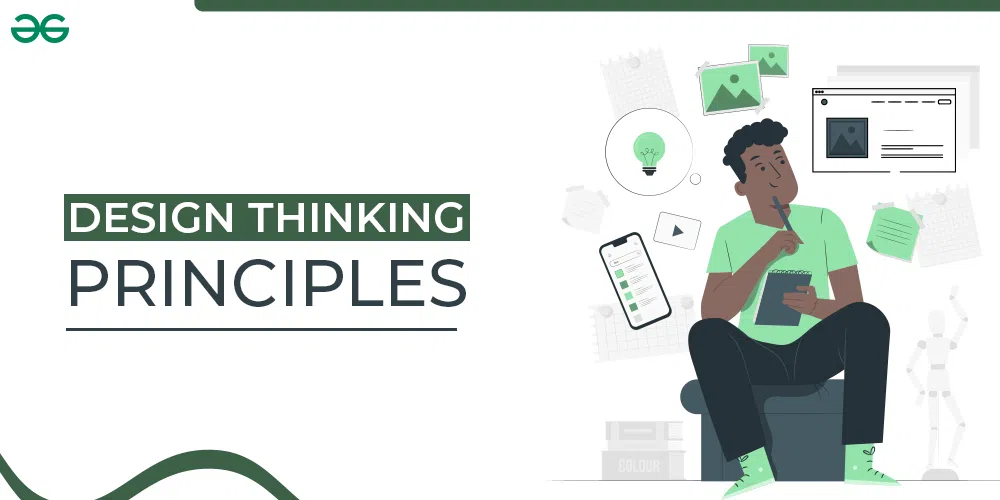How to use Design Thinking principles in UI/UX Design ?
Last Updated :
01 Nov, 2023
Design thinking is basically a creative way to solve problems. It is the sum of all the processes that result in designing of a prototype, Design thinking is all about showing empathy with the user. The most important skills for design thinking are – having empathy for the users and prototyping. Even though there are many ways to solve design problems, design thinking is the most innovative and well as very commonly used method of problem-solving, that is why, in this article, we will discuss design thinking in depth.

Design Thinking principles
Design Thinking
Design Thinking is a philosophy and a set of tools to help you solve problems creatively. When a team is trying to create something new or when trying to solve a problem, design thinking can be used to help the team get to that solution but there are many processes that can be used for problem solving. Design thinking specifically focuses on the human-centered side of creative problem-solving. Design Thinking is about empathizing and figuring out who you are designing for. what their needs are? and then solving that problem. Design Thinking helps you innovate based on the needs of the customer so whereas many other problem-solving processes look from the technology point of view, design thinking helps you look at the problem from the human perspective.
Steps of Design Thinking
There are five main steps to any design thinking process even though in each of these steps themselves are the specific process and every designer does it differently but the five steps always remain the same.
- Understanding the challenge and empathizing.
- Defining the problem.
- Coming up with solutions.
- Creating a prototype.
- Testing the prototype, taking feedback and iterating.
Design Thinking principles in UI/UX Design
Using these 5 steps of design thinking principles, we can create professional designs and more importantly connect with the users to solve there problems, let’s look into these steps more and find out how these steps can be used in UI/UX design.
1. Empathize
Empathizing is basically understanding the people you’re trying to design the product or the service for. Empathizing a lot of the time is about gathering information, interviewing users, creating personas, trying to figure out who am I making this for? what is their problem? it is about empathizing with the people you are designing.
2. Define
After all the learnings we had in by gathering information, interviewing users, creating personas and trying to figure out things, now we are defining it and breaking it down so to come to some conclusions about what are the users needs based on everything we learned from interviewing the people. It helps us to know about what are the customer needs, what are their problems, what are their challenges, what are the insights we could take from these interviews. Through defining we can come up with conclusions about the challenges faced by users, the most common challenges and the most important challenges that should be prioritized.
3. Ideate
Ideate basically coming up with ideas. We have to come up with potential matches of products or services that have similar problems like ours , trying to match your solution with the insights we figured out with the empathize part. we here are coming up with ideas. This is the bit like a brainstorming session where you are outlooking into other people’s solutions related to the problems you are facing and trying to find the best possible solution. It is just like different people coming together, people sharing ideas, and people trying to come up with ideas for you. Ideation is about coming up with thoughts and ideas that match with what we learned in the previous steps.
4. Prototype
In web design, a prototype is a model of the website or the solution we are building. It is a representation of the solution that helps not just us designers but also developers and stakeholders to visualize the solution and test the user interface and functionality of the website and the solution. Through Prototyping we are taking all of the ideas we have and breaking them down into a select few ideas that we think might be worth working upon. And then we turn these ideas into simple testable prototypes. They are not fully designed or fully code but they are essentially a pseudo product that we can use to test with real users.
5. Test
We are now at a stage when we can test our solutions. Here we invite users to test out and respond to the prototype we created. Their responses will inform whether we can move forward on the idea or it is not good enough and kill our idea before wasting additional resources. In this final step we will perform testing with real people and these real people are selected based on what we learned in the step one. Now after this our job is to gather the feedback and iterate upon these design thinking principles again to refine our solution until these users are satisfied and then we can implement our solutions in the design.
Conclusion
Design Thinking is both an ideology and a process, it is solving complex problems in a user centric way. Design Thinking was created as a way of taking the processes and approaches that designers use and applying them to problems that designers don’t typically encounter.
Upon following the design thinking principles in the workflow, an designer can some closer to the user, understand his/her problems and some up with better solutions to the problems.
Share your thoughts in the comments
Please Login to comment...